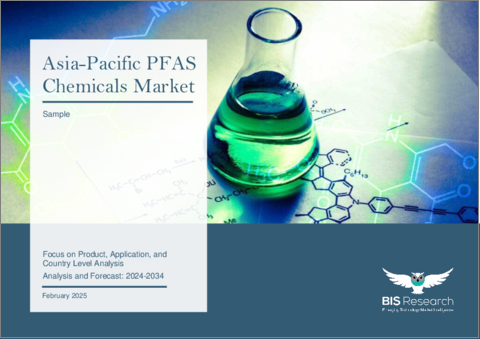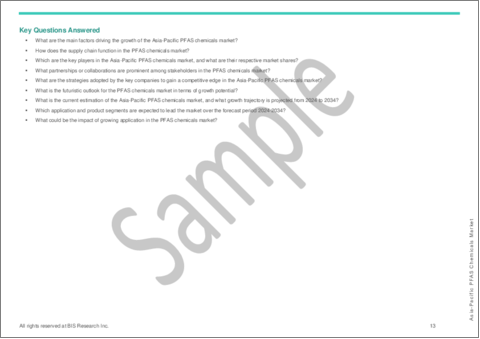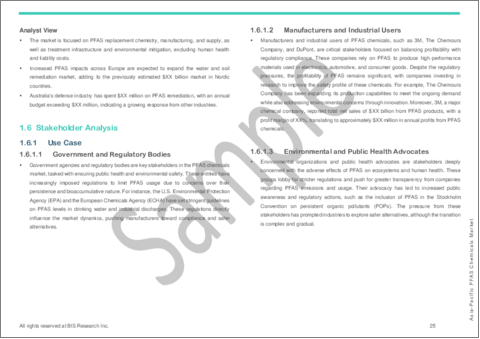|
|
市場調査レポート
商品コード
1661674
アジア太平洋地域のPFAS化学品市場:製品・用途・国別の分析・予測 (2024-2034年)Asia-Pacific PFAS Chemicals Market: Focus on Product, Application, and Country Level Analysis - Analysis and Forecast, 2024-2034 |
||||||
カスタマイズ可能
|
|||||||
| アジア太平洋地域のPFAS化学品市場:製品・用途・国別の分析・予測 (2024-2034年) |
|
出版日: 2025年02月26日
発行: BIS Research
ページ情報: 英文 71 Pages
納期: 1~5営業日
|
- 全表示
- 概要
- 図表
- 目次
アジア太平洋のPFAS化学品の市場規模は、2024年の142億6,000万米ドルから、予測期間中は5.34%のCAGRで推移し、2034年には240億米ドルに達すると予測されています。
同地域のPFAS化学品市場は、法律の厳格化と環境の持続可能性への関心の高まりの結果、劇的に拡大すると予想されます。より安全な代替品へのニーズは、PFAS暴露に伴う健康被害に対する一般市民の意識の高まりによって高まっています。PFAS管理は、より厳格な規制遵守とよりクリーンな工業プロセスに重点を置く検出・浄化技術の進歩の結果として変化しています。
| 主要市場統計 | |
|---|---|
| 予測期間 | 2024-2034年 |
| 2024年評価 | 142億6,000万米ドル |
| 2034年予測 | 240億米ドル |
| CAGR | 5.34% |
アジアにおけるPFAS化学品市場は、規制圧力の高まりと、PFASが人の健康と環境にもたらす危険性に対する社会的認識の高まりの結果、大きく拡大しています。永遠の化学品とも呼ばれるこれらの物質は、分解されにくいため、環境と人体の両方に残留します。アジア太平洋地域全体の政府がより厳しい環境基準や規制を施行する中で、PFAS汚染に対するより安全な代替品やより効率的な救済策の必要性が高まっています。
汚染に対する懸念が高まるにつれ、この地域の産業界は、空気、水、土壌からPFASを特定し除去するための最先端技術を積極的に探しています。最先端のPFAS検出および浄化技術の研究開発への投資は、持続可能な産業慣行への動きによって推進されています。
PFASへの暴露による健康被害に関する一般市民の意識向上キャンペーンも、より環境に優しい生産方法やより安全な化学品の代替品を生み出すよう企業を後押しし、市場力学を変化させています。政府、企業、学術機関が協力してPFAS汚染に対処し、持続可能な解決策を生み出すことも市場を後押ししています。アジアにおけるPFAS化学薬品市場は、規制の枠組みが変化し続け、環境と公衆衛生の保全が保証されつつある中で、大幅な革新と拡大が見込まれています。
当レポートでは、アジア太平洋地域のPFAS化学品の市場を調査し、主要動向、市場影響因子の分析、法規制環境、技術開発・特許の動向、ケーススタディ、市場規模の推移・予測、各種区分・主要国別の詳細分析、競合情勢、主要企業のプロファイルなどをまとめています。
市場の分類
セグメンテーション1:用途別
- 建築・建設
- エレクトロニクス
- 化学工業 (石油化学を含む)
- 金属製造
- 塗料・コーティング
- 発泡剤・冷媒・冷却剤・難燃剤
- プラスチック・ゴム製造
- その他
セグメンテーション2:製品タイプ別
- フルオロテトラマー系物質
- パーフルオロアルカンスルホニル系物質
- パーフルオロアルキルカルボニル系物質
- パーフルオロ (ポリ) エーテル系物質
- フルオロポリマー
- その他
セグメンテーション3:国別
- 中国
- 日本
- オーストラリアおよびニュージーランド
- 韓国
- インド
- タイ
- インドネシア
- その他
目次
エグゼクティブサマリー
範囲と定義
第1章 市場
- 動向:現在および将来の影響評価
- PFASの修復と環境浄化技術への注目
- さまざまな産業におけるフルオロポリマーの幅広い用途
- サプライチェーンの概要
- バリューチェーン分析
- 価格予測
- 研究開発レビュー
- 特許出願動向 (国別・企業別)
- 規制状況
- PFASの潜在的市場規模
- ステークホルダー分析
- 使用事例
- 市場力学の概要
- 市場促進要因
- 市場抑制要因
- 市場機会
第2章 地域
- 地域別概要
- 推進因子・抑制因子
- アジア太平洋
- 地域概要
- 市場成長の原動力
- 市場課題
- 用途
- 製品
- アジア太平洋 (国別)
第3章 市場:企業プロファイル
- 次なるフロンティア
- AGC Inc.
- DAIKIN INDUSTRIES, Ltd.
- DONGYUE GROUP
第4章 調査手法
List of Figures
- Figure 1: Asia-Pacific PFAS Chemicals Market (by Scenario), $Million, 2023, 2027, and 2034
- Figure 2: PFAS Chemicals Market (by Region), $Million, 2023, 2027, and 2034
- Figure 3: Asia-Pacific PFAS Chemicals Market (by Application), $Million, 2023, 2027, and 2034
- Figure 4: Asia-Pacific PFAS Chemicals Market (by Product Type), $Million, 2023, 2027, and 2034
- Figure 5: Key Events
- Figure 6: Supply Chain Analysis for PFAS Chemicals Market
- Figure 7: Patent Filed (by Country), January 2021-July 2024
- Figure 8: Patent Filed (by Company), January 2021-July 2024
- Figure 9: Impact Analysis of PFAS Chemicals Market Navigating Factors, 2023-2034
- Figure 10: Capital Expenditure in Semiconductor Industry, $Billion, 2018-2022
- Figure 11: China PFAS Chemicals Market, $Million, 2023-2034
- Figure 12: Japan PFAS Chemicals Market, $Million, 2023-2034
- Figure 13: Australia and New Zealand PFAS Chemicals Market, $Million, 2023-2034
- Figure 14: South Korea PFAS Chemicals Market, $Million, 2023-2034
- Figure 15: India PFAS Chemicals Market, $Million, 2023-2034
- Figure 16: Thailand PFAS Chemicals Market, $Million, 2023-2034
- Figure 17: Indonesia PFAS Chemicals Market, $Million, 2023-2034
- Figure 18: Rest-of-Asia-Pacific PFAS Chemicals Market, $Million, 2023-2034
- Figure 19: Strategic Initiatives, January 2021-July 2024
- Figure 20: Share of Strategic Initiatives, January 2021-July 2024
- Figure 21: Data Triangulation
- Figure 22: Top-Down and Bottom-Up Approach
- Figure 23: Assumptions and Limitations
List of Tables
- Table 1: Market Snapshot
- Table 2: Opportunities Across Region
- Table 3: Competitive Landscape Snapshot
- Table 4: Trends Overview
- Table 5: Regulatory-Related Actions from the Environmental Protection Agency's (EPA) PFAS Action Plan That Are Ongoing
- Table 6: Major Applications and Uses of Fluoropolymers
- Table 7: Average Sales Pricing Forecast of PFAS Class Chemicals and Polytetrafluoroethylene (PTFE), $Thousand/Metric Ton, 2023-2034
- Table 8: Asia-Pacific PFAS Chemicals Regulatory Framework
- Table 9: PFAS Chemicals Market (by Region), $Million, 2023-2034
- Table 10: Asia-Pacific PFAS Chemicals Market (by Application), $Million, 2023-2034
- Table 11: Asia-Pacific PFAS Chemicals Market (by Product Type), $Million, 2023-2034
- Table 12: China PFAS Chemicals Market (by Application), $Million, 2023-2034
- Table 13: China PFAS Chemicals Market (by Product Type), $Million, 2023-2034
- Table 14: Japan PFAS Chemicals Market (by Application), $Million, 2023-2034
- Table 15: Japan PFAS Chemicals Market (by Product Type), $Million, 2023-2034
- Table 16: Australia and New Zealand PFAS Chemicals Market (by Application), $Million, 2023-2034
- Table 17: Australia and New Zealand PFAS Chemicals Market (by Product Type), $Million, 2023-2034
- Table 18: South Korea PFAS Chemicals Market (by Application), $Million, 2023-2034
- Table 19: South Korea PFAS Chemicals Market (by Product Type), $Million, 2023-2034
- Table 20: India PFAS Chemicals Market (by Application), $Million, 2023-2034
- Table 21: India PFAS Chemicals Market (by Product Type), $Million, 2023-2034
- Table 22: Thailand PFAS Chemicals Market (by Application), $Million, 2023-2034
- Table 23: Thailand PFAS Chemicals Market (by Product Type), $Million, 2023-2034
- Table 24: Indonesia PFAS Chemicals Market (by Application), $Million, 2023-2034
- Table 25: Indonesia PFAS Chemicals Market (by Product Type), $Million, 2023-2034
- Table 26: Rest-of-Asia-Pacific PFAS Chemicals Market (by Application), $Million, 2023-2034
- Table 27: Rest-of-Asia-Pacific PFAS Chemicals Market (by Product Type), $Million, 2023-2034
- Table 28: Market Share, 2023
Introduction to Asia-Pacific PFAS Chemicals Market
The Asia-Pacific PFAS chemicals market is projected to reach $24.00 billion by 2034 from $14.26 billion in 2024, growing at a CAGR of 5.34% during the forecast period 2024-2034. APAC's PFAS chemicals market is expected to expand dramatically as a result of stricter laws and increased attention to environmental sustainability. The need for safer substitutes is being driven by growing public awareness of the health hazards associated with PFAS exposure. PFAS management is changing as a result of advancements in detection and remediation technologies, which place an emphasis on more stringent regulatory compliance and cleaner industrial processes.
Market Introduction
| KEY MARKET STATISTICS | |
|---|---|
| Forecast Period | 2024 - 2034 |
| 2024 Evaluation | $14.26 Billion |
| 2034 Forecast | $24.00 Billion |
| CAGR | 5.34% |
The market for perfluoroalkyl substances (PFAS) chemicals in Asia is expanding significantly as a result of growing regulatory pressures and increased public awareness of the hazards that PFAS pose to human health and the environment. Often called "forever chemicals," these substances are persistent in both the environment and human bodies due to their resistance to degradation. The need for safer substitutes and more efficient remedies for PFAS contamination is growing as governments throughout the APAC area enforce more stringent environmental standards and regulations.
As worries about contamination increase, industries throughout the region are actively looking for cutting-edge technologies to identify and eliminate PFAS from air, water, and soil. Investment in research and development for cutting-edge PFAS detection and remediation techniques is being driven by the move towards sustainable industrial practices.
Public awareness campaigns about the health hazards of PFAS exposure are also changing market dynamics by pushing businesses to create more environmentally friendly production methods and safer chemical substitutes. Governments, businesses, and academic institutions working together to address PFAS pollution and create sustainable solutions are also helping the market. The market for PFAS chemicals in Asia is poised for substantial innovation and expansion as regulatory frameworks continue to change, guaranteeing the preservation of the environment and public health.
Market Segmentation
Segmentation 1: by Application
- Building and Construction
- Electronics Industry
- Chemical Industry (including Petrochemicals)
- Metal Manufacturing
- Paints and Coatings
- Blowing Agents, Refrigerants and Coolants, and Flame Retardants
- Production of Plastics and Rubber
- Others
Segmentation 2: by Product Type
- Fluorotelomer-Based Substances
- Perfluoroalkane Sulfonyl-Based Substances
- Perfluoroalkyl Carbonyl-Based Substances
- Perfluoro(poly)ether-Based Substances
- Fluoropolymers
- Others
Segmentation 3: by Country
- China
- Japan
- Australia and New Zealand
- South Korea
- India
- Thailand
- Indonesia
- Rest-of-Asia-Pacific
How can this report add value to an organization?
Product/Innovation Strategy: This report provides a comprehensive product/innovation strategy for the Asia-Pacific PFAS chemicals market, identifying opportunities for market entry, technology adoption, and sustainable growth. It offers actionable insights, helping organizations to meet environmental standards, gain a competitive edge, and capitalize on the increasing demand for eco-friendly solutions in various industries.
Growth/Marketing Strategy: This report offers a comprehensive growth and marketing strategy designed specifically for the Asia-Pacific PFAS chemicals market. It presents a targeted approach to identifying specialized market segments, establishing a competitive advantage, and implementing creative marketing initiatives to optimize market share and financial performance. By harnessing these strategic recommendations, organizations can elevate their market presence, seize emerging prospects, and efficiently propel revenue expansion.
Competitive Strategy: This report crafts a strong competitive strategy tailored to the Asia-Pacific PFAS chemicals market. It evaluates market rivals, suggests stand-out methods, and offers guidance for maintaining a competitive edge. By adhering to these strategic directives, companies can position themselves effectively in the face of market competition, ensuring sustained prosperity and profitability.
Key Market Players and Competition Synopsis
The companies profiled in the report have been selected based on input gathered from primary experts and analyzing company coverage, product portfolio, and market penetration.
Some of the prominent names in this market are:
- AGC Inc.
- DAIKIN INDUSTRIES Ltd.
- DONGYUE GROUP
Table of Contents
Executive Summary
Scope and Definition
1 Markets
- 1.1 Trends: Current and Future Impact Assessment
- 1.1.1 Increasing Focus on PFAS Remediation and Environmental Cleanup Technologies
- 1.1.2 Extensive Applications of Fluoropolymers across Various Industries
- 1.2 Supply Chain Overview
- 1.2.1 Value Chain Analysis
- 1.2.2 Pricing Forecast
- 1.3 Research and Development Review
- 1.3.1 Patent Filing Trend (by Country and Company)
- 1.4 Regulatory Landscape
- 1.5 Total Addressable Market for PFAS
- 1.6 Stakeholder Analysis
- 1.6.1 Use Case
- 1.6.1.1 Government and Regulatory Bodies
- 1.6.1.2 Manufacturers and Industrial Users
- 1.6.1.3 Environmental and Public Health Advocates
- 1.6.1.4 Consumers and the General Public
- 1.6.1 Use Case
- 1.7 Market Dynamics Overview
- 1.7.1 Market Drivers
- 1.7.1.1 Critical Role of PFAS in High-Performance Industries
- 1.7.1.2 Rising Demand for PFAS in Consumer Goods Driven by Performance Benefits
- 1.7.2 Market Restraints
- 1.7.2.1 Financial and Legal Liabilities Hindering PFAS Market Expansion
- 1.7.2.2 Detrimental Impact on Human Health Impeding Market Growth
- 1.7.3 Market Opportunities
- 1.7.3.1 Growing Demand in Electronics and Aerospace
- 1.7.3.2 Sustained Use in Consumer Goods Despite Regulatory Pressure
- 1.7.1 Market Drivers
2 Regions
- 2.1 Regional Summary
- 2.2 Drivers and Restraints
- 2.3 Asia-Pacific
- 2.3.1 Regional Overview
- 2.3.2 Driving Factors for Market Growth
- 2.3.3 Factors Challenging the Market
- 2.3.4 Application
- 2.3.5 Product
- 2.3.6 Asia-Pacific (by Country)
- 2.3.6.1 China
- 2.3.6.1.1 Application
- 2.3.6.1.2 Product
- 2.3.6.2 Japan
- 2.3.6.2.1 Application
- 2.3.6.2.2 Product
- 2.3.6.3 Australia and New Zealand
- 2.3.6.3.1 Application
- 2.3.6.3.2 Product
- 2.3.6.4 South Korea
- 2.3.6.4.1 Application
- 2.3.6.4.2 Product
- 2.3.6.5 India
- 2.3.6.5.1 Application
- 2.3.6.5.2 Product
- 2.3.6.6 Thailand
- 2.3.6.6.1 Application
- 2.3.6.6.2 Product
- 2.3.6.7 Indonesia
- 2.3.6.7.1 Application
- 2.3.6.7.2 Product
- 2.3.6.8 Rest-of-Asia-Pacific
- 2.3.6.8.1 Application
- 2.3.6.8.2 Product
- 2.3.6.1 China
3 Markets - Company Profiles
- 3.1 Next Frontiers
- 3.1.1 AGC Inc.
- 3.1.1.1 Overview
- 3.1.1.2 Top Products/Product Portfolio
- 3.1.1.3 Top Competitors
- 3.1.1.4 Target End-Use Industries
- 3.1.1.5 Key Personnel
- 3.1.1.6 Analyst View
- 3.1.1.7 Market Share, 2023
- 3.1.2 DAIKIN INDUSTRIES, Ltd.
- 3.1.2.1 Overview
- 3.1.2.2 Top Products/Product Portfolio
- 3.1.2.3 Top Competitors
- 3.1.2.4 Target End-User Industries
- 3.1.2.5 Key Personnel
- 3.1.2.6 Analyst View
- 3.1.2.7 Market Share, 2023
- 3.1.3 DONGYUE GROUP
- 3.1.3.1 Overview
- 3.1.3.2 Top Products/Product Portfolio
- 3.1.3.3 Top Competitors
- 3.1.3.4 Target End-User Industries
- 3.1.3.5 Key Personnel
- 3.1.3.6 Analyst View
- 3.1.3.7 Market Share, 2023
- 3.1.1 AGC Inc.
4 Research Methodology
- 4.1 Data Sources
- 4.1.1 Primary Data Sources
- 4.1.2 Secondary Data Sources
- 4.1.3 Data Triangulation
- 4.2 Market Estimation and Forecast





